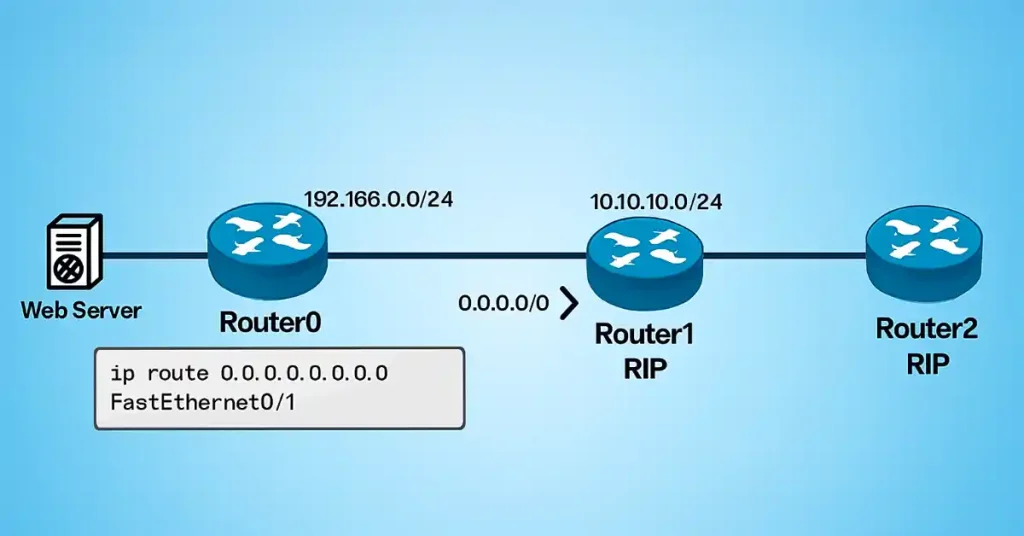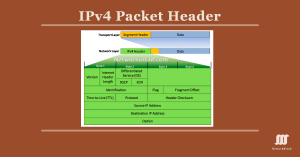Propagating a default route in RIP is a key feature of the Routing Information Protocol (RIP), a distance-vector routing protocol commonly used in small networks. It uses hop count as its metric and is suitable for CCNA-level studies, where understanding basic dynamic routing is key. A default route (0.0.0.0/0), also known as the gateway of last resort, directs traffic for unknown destinations, such as to the Internet. Propagating a default route in RIP is crucial in networks with a single exit point, such as an edge router connected to an ISP. This allows centralized configuration on the edge router, reducing administrative overhead. In real-world scenarios, this is common in branch offices where the headquarters router propagates defaults to remote sites.
Prerequisites
Before configuring default route propagation in RIP:
- Ensure Cisco IOS supports RIP (most versions do; use 12.4+ for stability).
- Enable RIP version 2 for classless routing and VLSM support (command: version 2 under router rip).
- Configure IP addresses on interfaces and ensure they are up/up (use no shutdown).
- Add correct network statements in RIP for all participating subnets.
- Topology: Assume a linear setup with Router0 as the edge router connected to an external network (web server representing the Internet).
Interface configurations (example IPs based on topology):
- Router0: FastEthernet0/0 – 192.168.0.1/24 (to web server at 192.168.0.2), FastEthernet0/1 – 10.10.10.1/24 (to Router1).
- Router1: FastEthernet0/0 – 10.10.10.2/24 (to Router0), FastEthernet0/1 – 172.16.0.1/24 (to Router2).
- Router2: FastEthernet0/0 – 172.16.0.2/24 (to Router1).
How to Propagate a Default Route in RIP
We can advertise a default route using RIP. Route propagation is useful when there is a single exit point in the network to reach the Internet or any other service. The default-information originate command in router configuration mode allows for default static route advertisement, so we need to configure the router with this command.
Refer to Figure 1. In this topology, Router0 is the single exit point to the external network (represented by the web server). So, all that is required for Router0 to reach the web server is a default static route going out of the FastEthernet0/0 interface (pointing to next-hop 192.168.0.2). It is much easier to configure a static default route on the edge router (Router0 in this topology). Then, Router0 propagates it to all other routers using RIP.

To provide web connectivity to all other networks in the RIP routing domain, the default static route also needs to be advertised to all other routers that use the dynamic routing protocol. Propagating a default route, Router0 must be configured with:
- Router0>enable
- Router0#config terminal
- Router0(config)#ip route 0.0.0.0 0.0.0.0 FastEthernet 192.168.0.2
- Router0(config#router rip
- Router(config-router)#network 192.168.0.0
- Router(config-router)#network 10.10.10.0
- Router(config-router)#default-information originate
- Router(config-router)do wr
The default-information originate command propagates the static default route in RIP updates. Router0 now has a Gateway of Last Resort and a default route installed in its routing table. Now configure a RIP (Routing Information Protocol) on Router1 and Router2 to propagate the default static route to Router1 and Router2. We can verify the default static route on the routing table of Router1 and Router2 using the show ip route command. If we check the routing table of Router1 and Router2, it will display a default static route and the gateway of last resort, but when we check the show startup-config, there will be no default route configured in the startup configuration file.
FAQs
What is the purpose of propagating a default route in RIP?
Propagating a default route in RIP is useful for networks with a single exit point to the Internet or services. It allows the edge router to advertise a static default route to other routers via RIP updates, ensuring efficient connectivity without manual configuration on each device. This simplifies management in dynamic routing domains.
Which command enables default route propagation in RIP?
The default-information originate command, entered in router RIP configuration mode, propagates the static default route in RIP updates. First, configure the static route with ip route 0.0.0.0 0.0.0.0 [interface or next-hop], then add networks and originate the default to share it with peers.
How do you verify the propagated default route on other routers?
Use the show ip route command on Router1 and Router2 to check for the default route and gateway of last resort in the routing table. It will appear as installed via RIP, but won’t show in the startup configuration (show startup-config) since it’s dynamically learned, not statically set.
What topology is used in the example for RIP default route propagation?
The topology features Router0 as the edge router connected to a web server on 192.168.0.0/24, with a default static route out FastEthernet0/1. Router0 links to Router1 on 10.10.10.0/24, and Router1 to Router2, all using RIP to propagate the default route eastward for web access.
Why configure the default route only on the edge router in RIP?
Configuring the default static route solely on the edge router (like Router0) and propagating it via RIP avoids redundant setups on Router1 and Router2. This ensures all routers in the domain receive the route dynamically, providing web connectivity efficiently through a single exit point.





